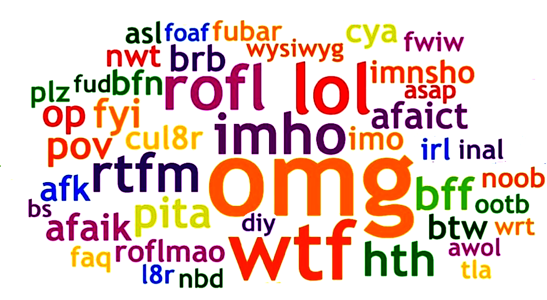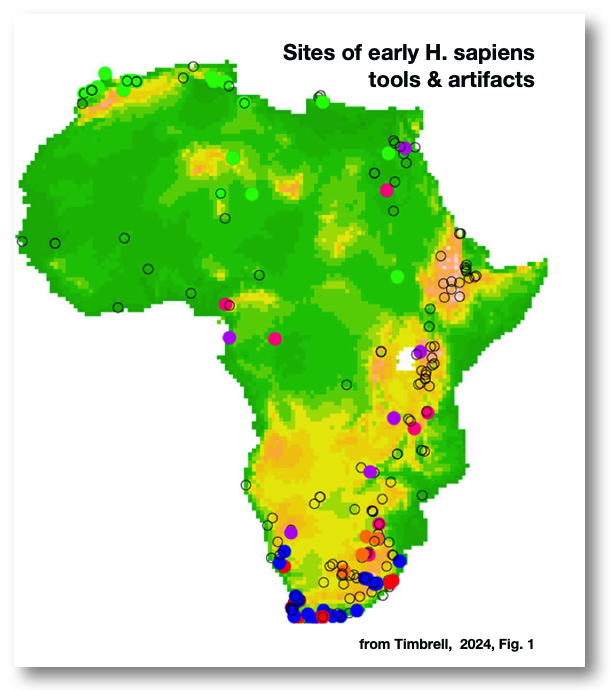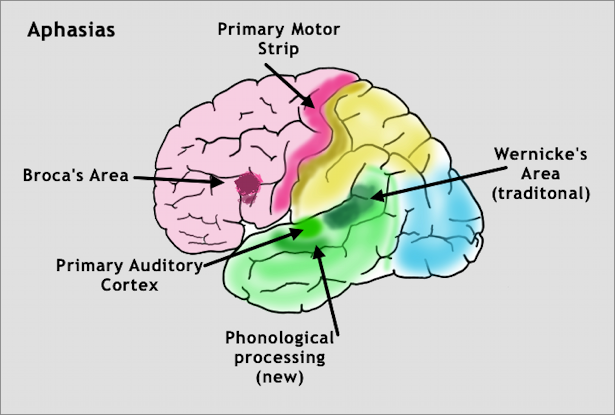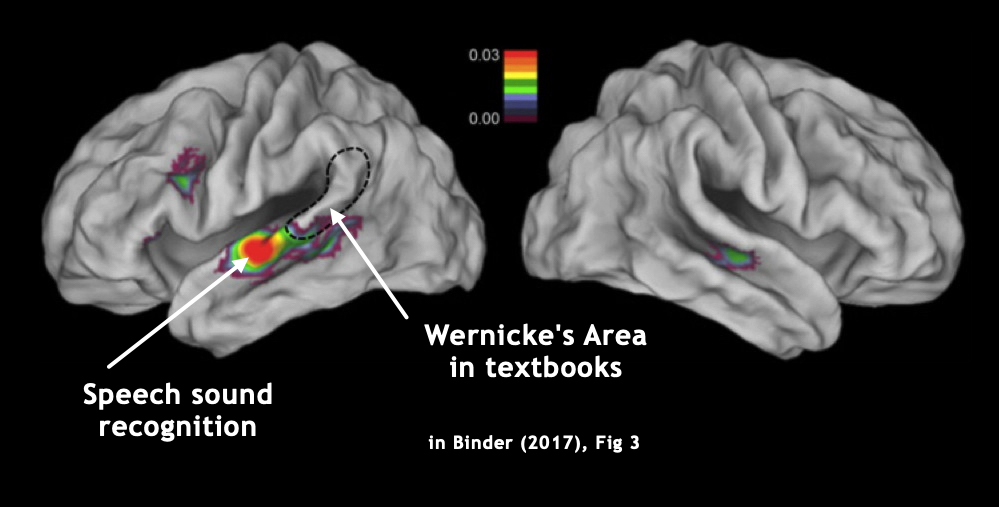|
|
PSY 340 Brain and Behavior Class 38: Evolution and Physiology of Language [Outline] |
|
|
|
PSY 340 Brain and Behavior Class 38: Evolution and Physiology of Language [Outline] |
|
The Evolution and Physiology of Language
All living creatures communicate in some fashion using sound, sight, motions, touch, odors etc. as means of signalling.
- Cobra snakes expand their hood to scare other creatures
- Wolves howl to call to others in their pack
- Baboons use touch in grooming each other and showing affection
- Cats mark their territories by rubbing against objects to mark them with their scent
A. Human language is unique because of it productivity, that is, its ability to produce new signals to represent new ideas.
Human language is distinct from all other known animal forms of communication in being compositional. Human language allows speakers to express thoughts in sentences comprising subjects, verbs and objects—such as ‘I kicked the ball’—and recognizing past, present and future tenses. Compositionality gives human language an endless capacity for generating new sentences as speakers combine and recombine sets of words into their subject, verb and object roles. For instance, with just 25 different words for each role, it is already possible to generate over 15,000 distinct sentences. Human language is also referential, meaning speakers use it to exchange specific information with each other about people or objects and their locations or actions. (Pagel, 2017)
Consider how the invention of the Internet has forced us to create a whole new set of symbols and ways of conveying meanings.

B. Nonhuman Precursors to Language
a. The chimpanzees seldom used the symbols in new original combinations (they are not productive).
b. The chimpanzees used their symbols almost always to make a request, only rarely to describe.
c. The chimpanzees produced requests far better than they seem to understand anyone else's request.
d. They do show a moderate degree of understanding of what is communicated to them, e.g., "who?" questions answered by names; "what?" questions answered by things; and "where?" questions answered by places.
2. Bonobos (Pan paniscus) , a "cousin" of the common chimpanzee, when given language training uses symbols in several ways that more resemble humans than common chimpanzees:
a. They understood more information than they produce.
b. They use symbols to name and describe objects even when they are not requesting them.
c. They request items that they do not see.
d. They occasionally use the symbols to describe past events.
e. They frequently make original, creative requests.3. The reason for the better language skills in the bonobos than in chimps is unknown.
4. Nonprimates: Alex, African gray parrot (1976-2007)
- Alex had relatively extensive language ability with specific objects & concepts
- Argument that this ability relates to general intelligence needed to deal with diverse environment of jungles
- Parrots live in the wild ca. 24 years, but like apes in captivity have lifespans of 30-60 years
C. How Did Humans Evolve Language?
1. Is Language Just a Product of Overall Intelligence or a Specialized Adaptation? Answer: Probably a Specialized Adaptation
b. Phonological loop, that is, the ability to hear and remember something (remember that this loop is one of the elements in Baddeley's model of working memory).
Gestures involving the face and mouth
c. People with Normal Intelligence but Impaired Language
"KE" Family (a British Caucasian family; incorrectly described as of Pakistani origin) & "CS" (an unrelated English boy with same language problem) [Developmental Verbal Dyspraxia]
- Genetic defect on Chromosome 7: FOXP2 ["Forkhead Box P2] gene
Conclusion 1: General intelligence is not sufficient for language.
d. People with Intellectual Disability (Low Intelligence) but Relatively Spared Language
Williams syndrome (also known as Williams-Beuren Syndrome) = people with intellectual disability but good language skills. Also musical rhythm ability. Fascination with faces (fusiform gyrus is 2X normal).
A rare disorder (~1 in 20,000 births according to Kalat; ~1 in 8000 live births according to Haas & Reiss, 2012) in which individuals with intellectual impairments have relatively skillful use of language, but limited abilities in other regards. This disorder is caused by a deletion of several genes from chromosome 7.
New/Not in book:
Evelina Fedorenko (MGH/Harvard) & Rosemary Varley (UCL, UK; 2016) report that "language and thought are not the same thing" on the basis of multiple neuroimaging studies
- Patients with global aphasia (= have almost no ability to understand or produce language) can still "add/subtract, solve logic problems, thing about other person's thoughts, appreciate music, and successfully navigate their environments" (abstract)
Conclusion 2: Language does not appear to be a by-product of general intelligence or general intellectual activity
2. Is Language a Speciaiization of the Brain?
a. Noam Chomsky: language acquisition device (LAD).
- poverty of the stimulus argument
- "symbolic thinking" - language arose to help us organize our thoughts internally via symbolic representation we can manipulate
b. A Sensitive ("Critical") Period for Language Learning
- Late vs. Early Second Language Learning
- Deaf children: Early learning of sign language = better use of sign language
- NOT IN BOOK: See, also, the experience of what are called "feral children'
Conclusion 3: There is no language module which automatically causes a person to learn to speak. Rather the predisposing neural structures require social experience in the company of other people in order to develop most appropriately.
3. Language and the "Social Brain" Hypothesis (not in textbook)
a. All language develops within social contexts
b. Robin Dunbar (U Liverpool, UK) and others propose that language developed as a way of helping organize larger and larger social grouping. This "social brain" hypothesis rests upon a variety of observations including two advantages conveyed by language:
- the ability to categorize individuals into distinct types (e.g., doctor, sheriff, chief)
- the ability to instruct other individuals about how they should respond "toward specific types of individuals within society" (Dunban, 1993)
Essentially, language permits societies of much larger size than would be possible otherwise. Such groups, e.g., bands, tribes, etc., have an survival advantage vis-a-vis those who do not have language.
c. Theory of Mind, Mental Time Travel, & Narrative as Factors in the Evolution of Language
- "Theory of Mind" (TOM)
- Ability to understand the intentions and goals of another person or animal
- No evidence that our primate cousins such as chimpanzees have a TOM; they don't coordinate group activities as humans do via spoken language
- Mental Time Travel (MTT): Episodic memory + Episodic future thinking (see above)
- Narrative: Putting together human experiences and concerns in a causal sequence = telling a story
D. When did human language evolve/develop?

- When did Homo sapiens (modern humans) emerge as a species? 230 kya ± 22 kya in the Great Rift Valley.
- Over the next 100-150 kya (and particularly after 50 kya). H. sapiens migrated from Eastern Africa to the other continents.
- Today there are approximately 7,100 different languages in the world.
- BUT, among ALL languages spoken, they share striking similarities in how they are constructed phonologically (sound-wise), syntatically (grammar-wise), and semantically (in terms of linguistic meaning).
- This points to a common biological and neurological origin for human language itself.
- So, before all of this migration took place, when was the last time that the original H. sapiens were last centered together in a common grouping?
- Using genetic markers from whole genomes of African populations, Miyagawa et al. (2025) found that "linguistic potential must have been present in the H. sapiens population at the latest by 135 kya"
- For the following 100,000 years these early humans used language to become the "symbolically-mediated beings familiar today."
- Symbolically-mediated = creating art such as cave drawings, designing dwellings, sculpting wood and stone, making tools to dig, to eat, or to make images of gods or spirits.
E. Strengths Associated with Human Language (Sedivy, 2024)
- Aligning our minds and connecting with others
- Language arises often in intimate sensory settings: we learn better from those we know
- A lifetime of linguistic abilities can help compensate for limitations of old age.
D. Brain Damage and Language
1. Aphasia = Severe acquired language impairment due to damage to the brain's language areas (for most people in the left hemisphere).


Causes of aphasia include
- Stroke (ischemic or hemorrhagic)
- Traumatic brain injury (TBI), e.g., automobile accident, falling & hitting head on ground
- Infectious diseases: meningitis, encephalitis, Herpes Simplex Virus (HSV), HIV, & various Streptococcus germs (especially causing an abscess in the brain).
- Brain tumors
- Progressive neurological disorders (Frontotemporal lobar degeneration [FTLD] & Alzheimer's disease)
2a. Broca's Area
2b. Wernicke's Area
3. Broca's aphasia (or nonfluent aphasia): A language impairment whose most prominent symptom is a deficit in language production. Caused by damage to Broca' area and surrounding areas.
4. Wernicke's aphasia or fluent aphasia = difficulty in comprehending the verbal and written communications of others. Although patients can still speak smoothly, their speech content is often nonsensical. They also have anomia (difficulty recalling the names of objects).
Wernicke's aphasia - Retired dentist (significantly impaired)
Wernicke's aphasia - Young woman (moderately impaired
E. Dyslexia
1. Dyslexia: Inability to read or significant difficulty with reading despite adequate vision and intelligence.
- Roughly 10-20% of population has a form of dyslexia
- Equally found in males and females
- Strong genetic component (children of dyslexic readers are much more likely to be dyslexic themselves)
- While remediation can help dyslexic readers improve, one does not "outgrow" the condition in adulthood
2. Compared to normal readers, dyslexic readers (both children and adults) show a distinctive pattern of brain functioning in the cortex of the left hemisphere. These include
- Underactivation in Verbal Word Form Area (in the fusiform gyrus of the left occipital-temporal cortex)
- Underactivation in the left temporo-parietal cortex
- Increased activation of the left inferior frontal cortex (including Broca's area)
3. As a rule, a dyslexic person is more likely to have a bilaterally symmetrical cerebral cortex (i.e., the planum temporale and other structures are the same size on the left and right hemisphere).
4. Other problems observed in persons with dyslexia (note that not all dyslexia shows all these problems):
a. Dysphonic dyslexia (dys = poor; phonos = sound) = difficulty sounding out printed words
b. Dyseidetic dyslexia (dys = poor; eidos = image) = difficulty recognizing words as a whole (though can sound them out)
c. Poor auditory memory: difficulty in remembering the sequence of sounds.
d. Dyslexia is a function of attentional differences in which there are problems attending to information directly in front of the reader, that is, dyslexic readers have a fixation point 5 to 10 degrees to the right or left of the word in front of them. Check out the image on the right side.
Try to keep your eye fixated on the dot in the middle while you try to read the letters on either the right or the left of the dot. Individuals with dyslexia often find it easier to do so than those who do not have dyslexia.